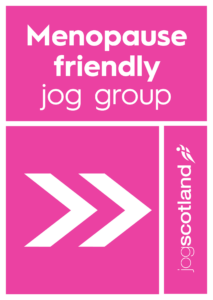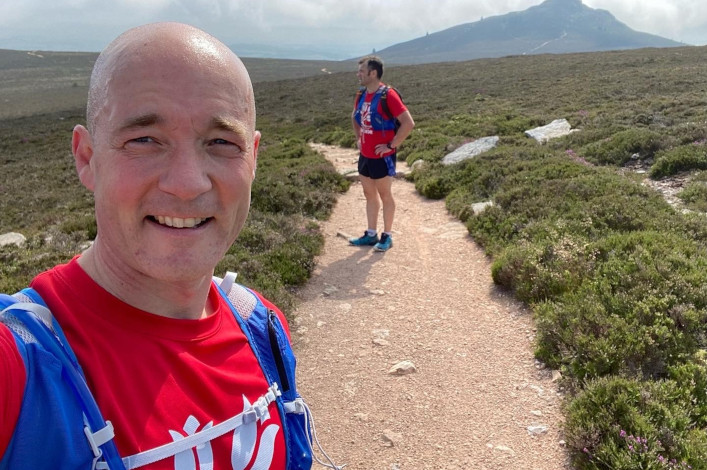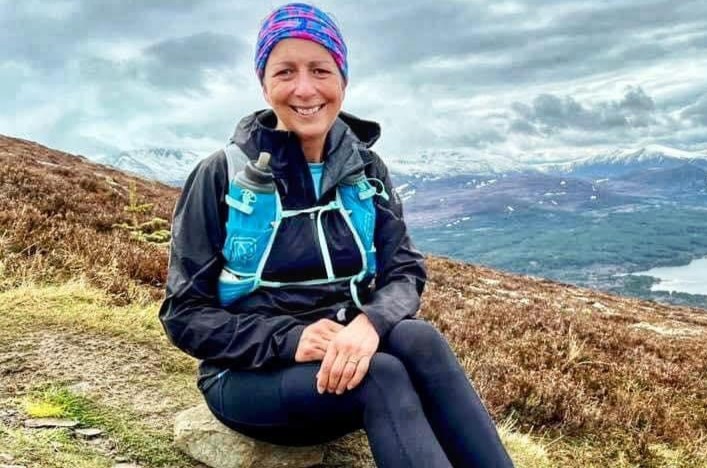Menopause and running

We are working to help our joggers learn about menopause, and help our jogging groups to become as welcoming as possible to those going through menopause, with the jogscotland #MenopauseFriendly campaign.
We want to change the script around menopause. We can’t alter the physical facts of it, but we can help those going through it. We want to create a world where jogscotland members going through menopause:
- Can feel strong, confident and proud of themselves, even when they’re facing difficult physical and mental challenges.
- Feel free to talk about their experiences without shame or embarrassment.
- Are informed and empowered, so that they can get the support they need from medical practitioners, friends and family.
- As a result of those things, stay active through menopause and beyond, at whatever level suits them.
We are working to help our joggers learn about menopause, and help our jogging groups to become as menopause friendly as possible.
Groups are invited to make some simple changes to their activities to achieve this, and pledge to talk more about menopause and open up the conversation. If they do this and register their commitment with us, they can use our ‘Menopause Friendly’ branding for promotion. Find out more.
The experience of menopause is different for everyone. For some it’s straightforward, but for others it can be physically and mentally overwhelming, and might make continuing to jog with a group feel very difficult. It can also be hard to talk about. We’d like to support our joggers in staying active through menopause, and help our jog leaders feel well-equipped to support joggers too. We’ve put together these pages with the help of a small focus group of jog leaders with lived experience of running through menopause, our partners SAMH, and information from the NHS Inform pages on menopause.
On this page, you’ll find basic information about menopause, and how it can affect joggers.
For lots of ideas and tips for joggers and jog leaders on keeping yourself and others active through menopause, you can then progress to read:
- Menopause friendly jogging groups
-
 We have recently introduced our menopause friendly jogging group logo. Groups displaying the logo will be taking steps to make their groups particularly welcoming to anyone who wants to stay active through menopause. You can find out more about them on:
We have recently introduced our menopause friendly jogging group logo. Groups displaying the logo will be taking steps to make their groups particularly welcoming to anyone who wants to stay active through menopause. You can find out more about them on:Menopause – advice for joggers
The following groups have signed up for the Menopause Friendly campaign:
Buggy Fitness Group Dunfermline
C25K Kickstarters with Nic & Fi
Cambuslang Harriers
East Kilbride Athletics Club
F.E.A.T Womens Fitness
Gala Harriers Joggers
Isle jog
Jiggly Joggers
Jog Scotland NAAC
JogForfar
Jogscotland Carnoustie
Jogscotland kintore
JogScotland Penicuik
jogscotland Ravenscraig and Strathclyde Park
Jogscotlandarran
Kickstart at Calaismuir
Klub Wanderers
Lets Go Linlithgow
Monkton Milers
Mums on the Run Hyndland
NMS Jogscotland (Team T. Rex)
Rogue Runners
Alness Area jogscotland
RunSum running group
Springburn Harriers
Springburn Harriers
STAART (St Andrews Adventure Running Team)
Team Purple-Jogachatalong
TGCR Kelso
The Galavanters
Try Trail Running
- Menopause – introduction
-
Menopause refers to the last menstrual period.
Menopause is a natural event, which typically occurs between the ages of 45 and 55, as levels of oestrogen drop in the body. The average age of menopause in the UK is 51. Some people experience early menopause, which may be spontaneous, or due to a medical condition, or a result of cancer treatment.
The time before menopause is called perimenopause, and is when many people experience the most symptoms. The time after the last period is postmenopause, generally recognised from 12 months after the last period. For many, symptoms will abate with postmenopause, but for some they will continue for longer.
For simplicity, in general on these pages, we will use the term ‘menopause’ to refer to the time from peri- to post-menopause, except where there is a specific need to differentiate between the different stages.
- Symptoms – it’s not just a hot flush
-
A wide variety of physical and mental symptoms can result from menopause, and they can appear (and disappear) throughout perimenopause, menopause and postmenopause. Everyone’s experience is different. Some may have few, or no symptoms at all. For others these symptoms are not just minor irritations – they can be debilitating and make everyday life difficult. Symptoms may also fluctuate from week to week, month to month, and year to year.
Symptoms can include:
- anxiety
- changes in mood – such as low mood or irritability
- changes in skin conditions, including dryness or increase in oiliness and onset of adult acne
- difficulty sleeping, which may cause tiredness and irritability during the day
- discomfort during sex
- fatigue
- feelings of loss of self
- hair loss or thinning
- headaches or migraines
- hot flushes – short, sudden feelings of heat, usually in the face, neck and chest, which can make your skin red and sweaty. There can also be a wider with temperature regulation – feeling hot one minute and cold the next.
- increase in facial hair
- incontinence and pelvic floor issues
- joint stiffness, aches and pains
- loss of self-confidence
- night sweats – hot flushes that occur at night
- palpitations – heartbeats that suddenly become more noticeable
- problems with memory, concentration and ‘brain fog’
- recurrent urinary tract infections (UTIs), such as cystitis
- reduced sex drive (libido)
- reduced running pace
- slower running recovery
- tinnitus
- vaginal dryness and pain
- weight gain
It’s easy to read all these symptoms and feel that menopause is something to approach with a sense of dread! But this is a comprehensive list, which doesn’t mean that everyone will experience them all. They are also likely to fluctuate, and there are things that can be done to help manage symptoms.
- How does this affect joggers?
-
Some of the symptoms above will have obvious effects on the ability to continue enjoying jogging – for example fatigue and joint aches. Others may be less obvious but can still have an impact. For example:
- Changes in mood can reduce motivation and confidence.
- Difficulty sleeping can reduce energy during the day.
- Temperature regulation issues like hot flushes can make exercise uncomfortable or awkward, with joggers constantly putting layers on and off.
- Excessive sweating during hot flushes may make joggers self-conscious.
- Physical symptoms such as UTIs, incontinence, irregular/heavy bleeding, breast tenderness or vulval dryness can make running uncomfortable or worrying.
- Irregular or heavy bleeding can be difficult to manage when out for a run.
- Brain fog can make it harder to concentrate or remember instructions and directions.
- Slower pace and recovery can be demoralising and make people want to drop out.
- How can running help with menopause symptoms?
-
As they go through menopause, we want our joggers to continue feeling strong, active, and capable. We are proud of every jogscotland member, and we want to keep our joggers active with their groups throughout menopause and beyond, even if their jogging life changes over the years.
With a little patience and exploration, it’s possible to use these years to set the groundwork for remaining healthy and energetic for many years to come.
Some of the ways that continuing to run with a jogscotland group can help joggers through menopause and beyond:
- Physical activity can help regulate the mood, improving symptoms of anxiety and depression. Being active outdoors, with other people, is particularly beneficial for mental health.
- Jogging groups can be great places to discuss all the things our body puts us through. If we’re already talking about our blisters, chafing and sweat rash, then why not menopause?! You’ll quite likely find other joggers in your group have experience of menopause that could be useful, and they’ll be happy to chat or offer moral support. If you feel awkward broaching the subject, jogging shoulder to shoulder without eye contact, can make it easier.
- Even though it can be hard to exercise through fatigue, if you can manage to get active, it’s often one of the quickest ways to boost your energy level.
- Running will help you maintain muscle mass and bone density, which both decrease through and after menopause.
- Being active can help control weight, and boost your body image and confidence.
- Some studies have suggested that running can help reduce the occurrence of hot flushes (example).
- Useful tips and ideas for joggers and jog leaders
-
For plenty of ideas and tips on dealing with the challenges that jogging through menopause can bring, read on…
- Useful links
-
- The NHS Inform website has an excellent section on menopause, including pages on signs and symptoms, treatments, and supporting someone else through menopause.
- Menopause café – organises get togethers where people can chat about menopause, and a festival called Flush Fest.
- Dr Juliet McGrattan writes on women’s health and running, – dip into her site, or view her articles tagged ‘menopause’.
- HRT for runners – an article by Juliet for Women’s Running magazine.
- Balance menopause – website run by Dr Louise Newson with a huge library of articles on menopause-related topics, and an associated app to help you track symptoms. Particularly strong on language inclusive of trans and non-binary people.
- Menopause and pelvic health – article by pelvic health physio Jo Dafforn for Nuffield Health, discussing 5 common symptoms and treatments.
- Menopause and diet – information and advice from the Association of UK Dietitians.
- Menopausal symptoms and cancer treatment – article by Macmillan Cancer Support. As well as discussing cancer-related menopause, has a good overview of menopause, symptoms and treatments.
- Menopause and running – what do clinicians and women need to know? By physiotherapist Claire Callaghan. A technical, but interesting, article focusing on the physical effects of menopause on our joints, bones and muscles.
- Black Women in Menopause was founded by Nina Kuypers in 2020 to create a safe space for Black women to share their experiences of menopause and receive support. She has featured in a campaign for Women in Sport campaign – Inspiring Women to be Active during Midlife and Menopause. She podiumed in the SPINE Challenger South 108-mile ultra-marathon, helping to shatter stereotypes in sport and menopause and redefine what’s possible.
More research is needed into the ways that menopause can vary for people of different ethnicities, but the American Study of Women’s Health Across the Nation (SWAN), reported that Black women reach menopause 8.5 months earlier compared to white women. They may also have a longer transition and experience more severe symptoms. Read more from Nina:The Colourless Menopause, The Voice magazine
Nina Kuypers on why she ran an ultramarathon for Wellbeing of Women




Latest Facebook update
Problem displaying Facebook posts. Backup cache in use.
Click to show error